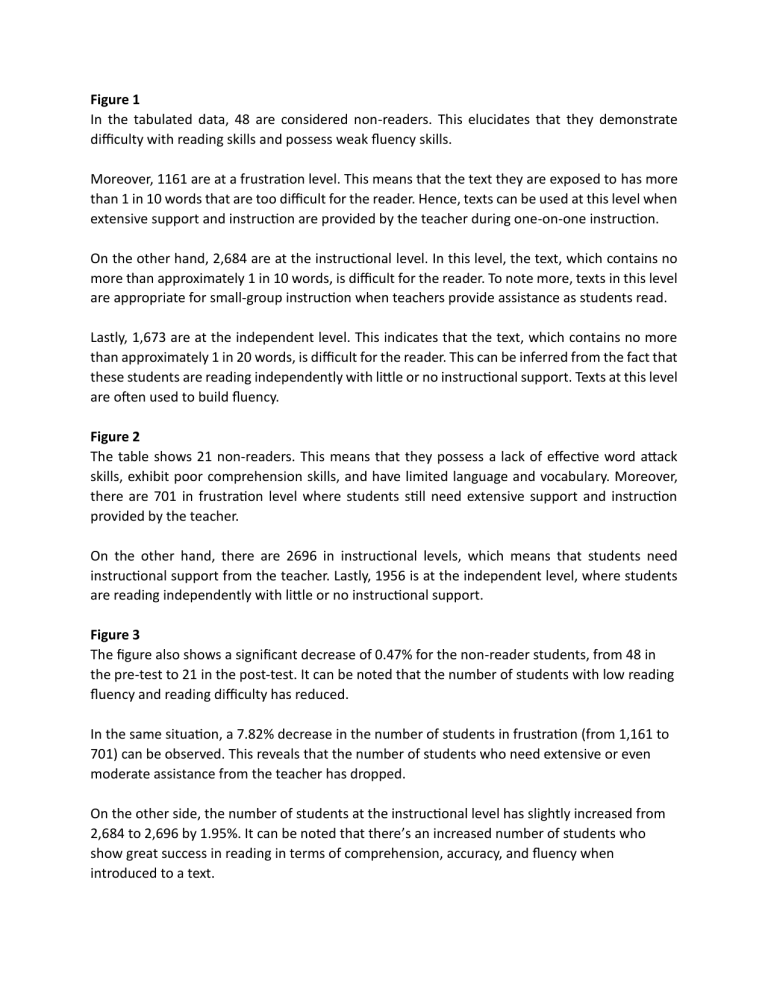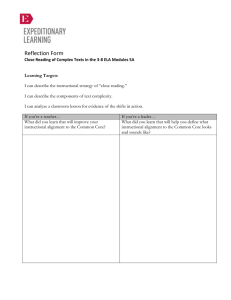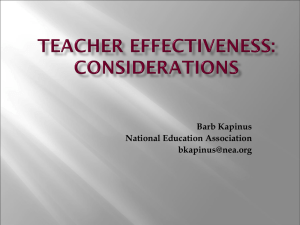
Figure 1 In the tabulated data, 48 are considered non-readers. This elucidates that they demonstrate difficulty with reading skills and possess weak fluency skills. Moreover, 1161 are at a frustration level. This means that the text they are exposed to has more than 1 in 10 words that are too difficult for the reader. Hence, texts can be used at this level when extensive support and instruction are provided by the teacher during one-on-one instruction. On the other hand, 2,684 are at the instructional level. In this level, the text, which contains no more than approximately 1 in 10 words, is difficult for the reader. To note more, texts in this level are appropriate for small-group instruction when teachers provide assistance as students read. Lastly, 1,673 are at the independent level. This indicates that the text, which contains no more than approximately 1 in 20 words, is difficult for the reader. This can be inferred from the fact that these students are reading independently with little or no instructional support. Texts at this level are often used to build fluency. Figure 2 The table shows 21 non-readers. This means that they possess a lack of effective word attack skills, exhibit poor comprehension skills, and have limited language and vocabulary. Moreover, there are 701 in frustration level where students still need extensive support and instruction provided by the teacher. On the other hand, there are 2696 in instructional levels, which means that students need instructional support from the teacher. Lastly, 1956 is at the independent level, where students are reading independently with little or no instructional support. Figure 3 The figure also shows a significant decrease of 0.47% for the non-reader students, from 48 in the pre-test to 21 in the post-test. It can be noted that the number of students with low reading fluency and reading difficulty has reduced. In the same situation, a 7.82% decrease in the number of students in frustration (from 1,161 to 701) can be observed. This reveals that the number of students who need extensive or even moderate assistance from the teacher has dropped. On the other side, the number of students at the instructional level has slightly increased from 2,684 to 2,696 by 1.95%. It can be noted that there’s an increased number of students who show great success in reading in terms of comprehension, accuracy, and fluency when introduced to a text. Lastly, the number of students in the independent level has also increased from 1,673 to 1,956 with 6.34%. This indicates that the many students can now read a text on their own with ease where they make hardly any errors, have excellent comprehension, and can read a story alone with confidence. Figure 4. Figure 4 shows 4,848 students' functional literacy levels for the school year 2023–2024 in grades 7–10 using the Language Enhancement Through Reading Assessment (LETRA). Ninety-four (94) students were able to achieve below-word level, 130 word level, 743 sentence level, 651 paragraph, 1408 story level, 332 comprehension-story level, 602 local material level, 203 comprehension level, 165 academic text level, and 388 comprehension-academic text level. The findings indicate that while a large portion of students (1408) were able to read the story with no more than three errors, they were unable to correctly answer at least five out of seven questions. The same is true for the 165 students in the academic text level and the 602 students in the local material level. A further scrutiny of the data reveals that students in the below word level were unable to read at least 10 out of 20 words, students in the word level were unable to read 5 sentences correctly, and students in the sentence level were unable to read at least 120–150 words in the paragraph within 1 minute. Figure 5. Figure 5 displays the oral reading levels of 4, 875 students in in grades 7-10 based on their preoral reading assessment for school year 2023-2024. Based on findings, 27 (1%) students are non-readers, and 963 (20%) are independent readers. Moreover, 1708 (35%) of students are at the frustration level, and 2177 (45%) students are at the instructional level. This implies that a significant number of students (45%) require assistance from a tutor, parent, or instructor. They gain more from reading instruction that is guided by the teacher. On the other hand, 35% of them find reading materials to be so challenging that they are unable to comprehend them. They need extensive support and instruction.





